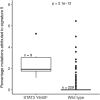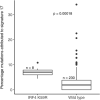Spectrum of mutational signatures in T-cell lymphoma reveals a key role for UV radiation in cutaneous T-cell lymphoma
- PMID: 33597573
- PMCID: PMC7889847
- DOI: 10.1038/s41598-021-83352-4
Spectrum of mutational signatures in T-cell lymphoma reveals a key role for UV radiation in cutaneous T-cell lymphoma
Abstract
T-cell non-Hodgkin's lymphomas develop following transformation of tissue resident T-cells. We performed a meta-analysis of whole exome sequencing data from 403 patients with eight subtypes of T-cell non-Hodgkin's lymphoma to identify mutational signatures and associated recurrent gene mutations. Signature 1, indicative of age-related deamination, was prevalent across all T-cell lymphomas, reflecting the derivation of these malignancies from memory T-cells. Adult T-cell leukemia-lymphoma was specifically associated with signature 17, which was found to correlate with the IRF4 K59R mutation that is exclusive to Adult T-cell leukemia-lymphoma. Signature 7, implicating UV exposure was uniquely identified in cutaneous T-cell lymphoma (CTCL), contributing 52% of the mutational burden in mycosis fungoides and 23% in Sezary syndrome. Importantly this UV signature was observed in CD4 + T-cells isolated from the blood of Sezary syndrome patients suggesting extensive re-circulation of these T-cells through skin and blood. Analysis of non-Hodgkin's T-cell lymphoma cases submitted to the national 100,000 WGS project confirmed that signature 7 was only identified in CTCL strongly implicating UV radiation in the pathogenesis of cutaneous T-cell lymphoma.
Conflict of interest statement
Research support was provided by Galderma. The funder had no role in the conceptualization, design, data collection, analysis, decision to publish, or preparation of the manuscript.
Figures







Similar articles
-
Primary cutaneous T-cell lymphoma (mycosis fungoides and Sézary syndrome): part I. Diagnosis: clinical and histopathologic features and new molecular and biologic markers.J Am Acad Dermatol. 2014 Feb;70(2):205.e1-16; quiz 221-2. doi: 10.1016/j.jaad.2013.07.049. J Am Acad Dermatol. 2014. PMID: 24438969 Review.
-
Single-cell RNA sequencing comparison of CD4+, CD8+ and T-cell receptor γδ+ cutaneous T-cell lymphomas reveals subset-specific molecular phenotypes.Br J Dermatol. 2025 Jan 24;192(2):269-282. doi: 10.1093/bjd/ljae313. Br J Dermatol. 2025. PMID: 39133553 Free PMC article.
-
Primary cutaneous peripheral T-cell lymphomas with a T-follicular helper phenotype: an integrative clinical, pathological and molecular case series study.Br J Dermatol. 2022 Dec;187(6):970-980. doi: 10.1111/bjd.21791. Epub 2022 Sep 2. Br J Dermatol. 2022. PMID: 35895386 Free PMC article.
-
Is Cutaneous T-Cell Lymphoma Caused by Ultraviolet Radiation? A Comparison of UV Mutational Signatures in Malignant Melanoma and Mycosis Fungoides.Cells. 2023 Jun 13;12(12):1616. doi: 10.3390/cells12121616. Cells. 2023. PMID: 37371087 Free PMC article.
-
Biological insights into the pathogenesis of cutaneous T-cell lymphomas (CTCL).Semin Oncol. 2006 Feb;33(1 Suppl 3):S3-6. doi: 10.1053/j.seminoncol.2005.12.015. Semin Oncol. 2006. PMID: 16516668 Review.
Cited by
-
Integrated driver mutations profile of chinese gastrointestinal-natural killer/T-cell lymphoma.Front Oncol. 2022 Aug 18;12:976762. doi: 10.3389/fonc.2022.976762. eCollection 2022. Front Oncol. 2022. PMID: 36059700 Free PMC article.
-
Phase 2 trial of the farnesyltransferase inhibitor tipifarnib for relapsed/refractory peripheral T-cell lymphoma.Blood Adv. 2024 Sep 10;8(17):4581-4592. doi: 10.1182/bloodadvances.2024012806. Blood Adv. 2024. PMID: 38991123 Free PMC article. Clinical Trial.
-
Phototherapy and mycosis fungoides: what's new?Dermatol Reports. 2023 Oct 17;16(Suppl 2):9830. doi: 10.4081/dr.2023.9830. eCollection 2024 May 7. Dermatol Reports. 2023. PMID: 39295876 Free PMC article. Review.
-
Cutaneous T-cell lymphomas: 2021 update on diagnosis, risk-stratification, and management.Am J Hematol. 2021 Oct 1;96(10):1313-1328. doi: 10.1002/ajh.26299. Epub 2021 Aug 2. Am J Hematol. 2021. PMID: 34297414 Free PMC article.
-
Advances in the understanding and treatment of Cutaneous T-cell Lymphoma.Front Oncol. 2022 Nov 24;12:1043254. doi: 10.3389/fonc.2022.1043254. eCollection 2022. Front Oncol. 2022. PMID: 36505788 Free PMC article. Review.
References
-
- Vose J, Armitage J, Weisenburger D, International T-Cell Lymphoma Project International peripheral T-cell and natural killer/T-cell lymphoma study: pathology findings and clinical outcomes. J. Clin. Oncol. Off. J. Am. Soc. Clin. Oncol. 2008;26:4124–4130. doi: 10.1200/JCO.2008.16.4558. - DOI - PubMed
Publication types
MeSH terms
Substances
Grants and funding
LinkOut - more resources
Full Text Sources
Other Literature Sources
Research Materials

